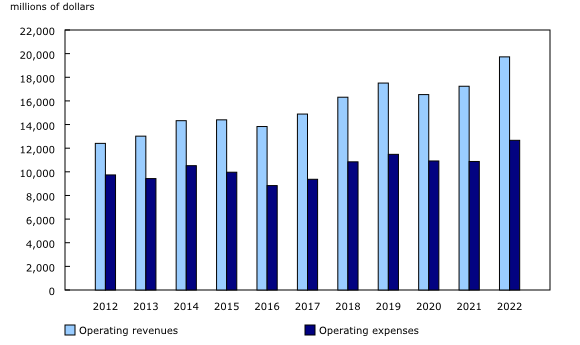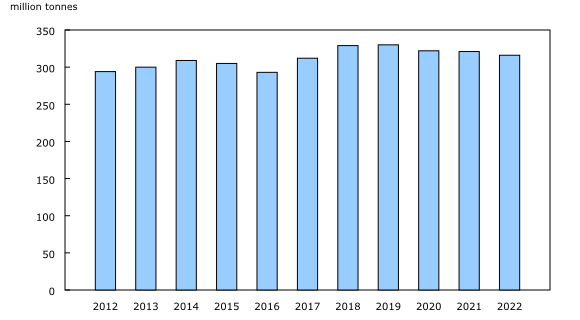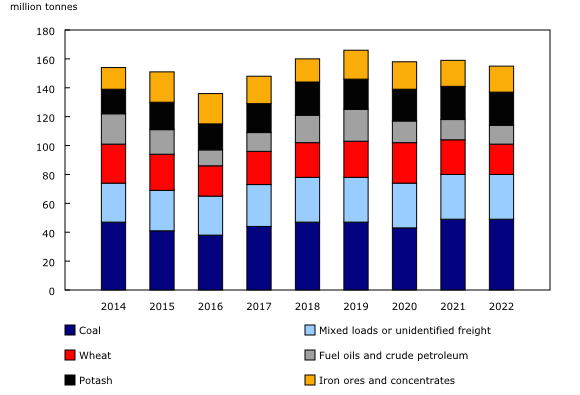Rail transportation, 2022
Released: 2024-04-12
Industry back on track
In 2022, the further easing of COVID-19 pandemic restrictions and rebalancing of supply chains contributed to the second consecutive yearly growth in revenues in the rail industry. Canadian railways posted operating revenues of $19.7 billion in 2022, up 14.4% from 2021.
The Canadian rail transportation industry is comprised of two mainline freight carriers, several shortline freight railways and passenger rail companies.
Freight revenues demonstrate strong growth
Freight revenues, which accounted for 89.5% of the rail industry's total operating revenues in 2022, increased 12.5% from 2021 to $17.7 billion. This rebound was not as significant as that of other industries, such as airlines, as railways were deemed an essential service during the pandemic and continued to move commodities and essential goods.
Shortline carriers were hit harder in 2021, as they often transport specific commodities or serve specific industries. However, in 2022, the operating revenues these carriers earned, which account for a fraction (4.0%) of the industry's total, experienced similar strong growth of 10.3%.
Passenger revenues rebound after restrictions are lifted
Revenues from rail ridership rebounded in 2022, which saw the easing of Canada-wide restrictions on non-essential travel during the pandemic. Passenger revenues more than doubled from $138 million in 2021 to $345 million in 2022. Other rail revenues, including government payments, increased 22.6% from 2021 to $1.7 billion in 2022.
Expenditures rise sharply
Total rail operating expenses rose 16.4% to $12.7 billion in 2022. Apart from a 3.7% decline in equipment expenses, all categories of operating expenses were up from the previous year. With more freight to haul and higher global oil prices, fuel expenditures by railways increased 50.8%, from $1.9 billion in 2021 to $2.9 billion in 2022.
However, the increase was more moderate in the other expense categories. For instance, general administration costs, which include wages and salaries, rose 7.1% to $2.0 billion in 2022, while way and structures expenses increased 6.0% to $2.8 billion.
Despite the sharp rise in overall expenditures, the industry operating ratio (i.e., operating expenses expressed as a proportion of operating revenue) increased marginally to 0.64, up from 0.63 in 2021. In financial terms, railways spent $64 generating $100 in revenue during 2022.
Wages and productivity increase
In 2022, the average number of railway employees reached 32,387, up 1.3% from 2021. While total annual wages and related benefits rose from $3.2 billion in 2021 to $3.4 billion (+5.8%) in 2022, labour productivity—revenue tonne-kilometres per railway employee—increased 7.1% to 14.2 million.
The railway industry experienced greater output, as measured by revenue tonne-kilometres—the movement of one tonne of revenue-generating freight over one kilometre of track. The total increased 8.4%, rising from 424 billion tonne-kilometres in 2021 to 460 billion tonne-kilometres in 2022, exceeding the pre-pandemic level of 2019.
In addition, the average number of cars per freight train in 2022 declined slightly to 116 cars, with average train speed unchanged, at 33 kilometres per hour.
Change in composition of transported commodities
While freight tonnage edged down 1.7% from one year earlier to 315.7 million tonnes in 2022, there were discernible changes in transported commodity composition.
During the first half of 2022, total traffic carried decreased slightly, driven by declines in loadings of some agricultural and food products. However, these products ended the year on a stronger note due to more favourable growing conditions across the Prairies.
At the same time, there was a high demand for energy products in 2022. As economic conditions drove energy prices to record highs, the sharp increase in exports of energy products helped offset the overall decline in freight tonnage.
Top commodities moved
The overall rail tonnage in 2022 was the lowest it had been since 2017, with nearly all of the top commodities, which contribute half of the entire freight volume, posting declines. While energy products, such as coal (48.6 million tonnes), and iron ores and concentrates (18.2 million tonnes) both dipped year over year, agricultural products such as wheat (-11.3% to 20.9 million tonnes) and canola (-26.3% to 6.9 million tonnes) recorded sharper declines.
Western Canada loadings mixed
Of all commodities that originated from a Canadian location in 2022, almost three-quarters (73.1%, or 193.7 million tonnes) came from Western Canada (Alberta, Saskatchewan, British Columbia and Manitoba).
Shipments of energy products from the west were mixed in 2022. For example, loadings of fuel oils and crude petroleum declined by 11.2% from 2021 to 11.5 million tonnes in 2022, while coal shipments increased by 2.6% to 38.7 million tonnes in 2022.
The decline in western loadings of farm-related commodities was widespread in 2022. Compared with 2021, carloadings of wheat (-11.2% to 19.9 million tonnes) and of canola (-26.3% to 6.8 million tonnes) were down in 2022. Meanwhile, loadings of potash, a non-metallic mineral used in the production of fertilizer, decreased slightly to 23.0 million tonnes.
The total tonnage loaded in Eastern Canada (including the Atlantic region, Ontario and Quebec) has changed very little in the past couple of years. In 2022, it accounted for 26.9% of all commodities that originated from a Canadian location. In Eastern Canada, iron ores and concentrates (16.7 million tonnes) and mixed loads or unidentified freight (12.0 million tonnes) were the two dominant commodities moved by rail.
Did you know we have a mobile app?
Get timely access to data right at your fingertips by downloading the StatsCAN app, available for free on the App Store and on Google Play.
Note to readers
With this release, financial data pertaining to reference year 2021 for regional rail companies, including operating revenues, operating expenses and net income for the year (Table 23-10-0046) have been revised, as well as data for assets, liabilities and equity for regional rail companies (Table 23-10-0048). Revisions were also made to railway industry property accounts for regional rail companies (Table 23-10-0050). This is due to the availability of new information.
This release is based on two data sources, an annual survey and a commodity origin and destination statistics administrative file from Transport Canada. The former collects financial as well as operating and employment data from a census of Canadian railways that provide for-hire freight and passenger services.
The commodity origin and destination statistics file measures the movements of commodities carried by Canadian National Railway (CN), Canadian Pacific Railway (CP), carriers that interline with CN and CP, as well as a number of shortline carriers that do not interline with either CN or CP.
Financial, operational and origin and destination data may change on a year-to-year basis as a result of fluctuations in currency exchange rates, reclassifications of accounts, etc. Data are also influenced by mergers, acquisitions and companies which may enter or exit the industry.
Data aggregations are available for Canada and select geographic regions.
It is important to note that the universe of shortline carriers changes regularly. In particular, in 2018, data from one company was added to the estimates for the first time. In previous years, this company was classified as inactive, and no estimates were made. Therefore, any comparison of 2018 data with that of previous years should be made with caution, as this constitutes a break in the series.
A shortline freight railway usually takes goods from one or more points to a point on the larger transportation network, which is usually a mainline railway, but may be a trans-shipment point onto another transportation mode. These are carriers with less than $250 million in annual revenues for at least two years in a row.
Mainline freight railways usually move goods on the larger transportation network and are carriers with $250 million and more in annual revenues for at least two years in a row.
Revenue tonne-kilometres: The movement of one tonne of freight that the railway earns revenue from over one kilometre of track.
Revenue freight per employee: Calculated by dividing the annual sum of revenue-producing tonnage by the average number of freight railway employees.
Revenue freight average haul: Calculated by dividing revenue tonne-kilometres by freight tonnage.
Contact information
For more information, or to enquire about the concepts, methods or data quality of this release, contact us (toll-free 1-800-263-1136; 514-283-8300; infostats@statcan.gc.ca) or Media Relations (statcan.mediahotline-ligneinfomedias.statcan@statcan.gc.ca).
- Date modified:





